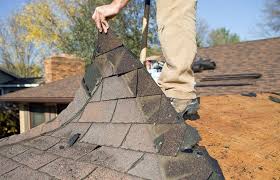The Lifespan of Various Roofing Materials Post-Installation
The lifespan of roofing materials is crucial in determining the long-term value and durability of a home or commercial property. Choosing the right material affects the building’s aesthetic appeal and influences its maintenance costs and energy efficiency. Roofs are exposed to the elements daily, meaning they must withstand diverse weather conditions. We will explore the expected lifespan of different roofing materials and the factors contributing to their longevity. Understanding these variables can guide homeowners and builders in making informed decisions for roofing projects.
Asphalt Shingles: A Durable Yet Affordable Option
Asphalt shingles are one of the most commonly used roofing materials due to their cost-effectiveness and decent lifespan. Typically, asphalt shingles can last between 15 to 30 years, depending on the quality of the shingles and the environmental conditions in which they are installed. In areas with moderate climates, asphalt shingles may approach the higher end of the lifespan range. At the same time, extreme weather conditions, such as heavy winds, hail, or intense sun exposure, can reduce their longevity. While asphalt shingles may need periodic repairs or replacements over time, their initial affordability and ease of installation make them an attractive option for many homeowners. The installation process is relatively simple and versatile, coming in various colors and designs that can complement any home style. However, regular maintenance, such as cleaning gutters and checking for loose or damaged shingles, can extend their lifespan.
Wood Shingles and Shakes: Natural Appeal with Variable Lifespan
Wood shingles and shakes offer a distinctive natural appearance that many homeowners find appealing. However, their lifespan can vary significantly depending on the type of wood, the region, and the level of maintenance. Wood shingles and shakes can last between 20 and 40 years. They differ primarily in thickness and texture, with shakes being thicker and more rugged. While these materials provide great insulation and aesthetic appeal, they are more vulnerable to weather conditions such as rain, snow, and wind.
Additionally, wood is susceptible to rot, insect infestations, and mold growth, which can shorten the lifespan of the roofing. Proper maintenance, such as applying protective coatings or treatments to resist moisture, can help extend the lifespan of wood roofing materials. However, these roofs may require more frequent inspection and care than other options.
Read more : Immerse Yourself in Selfie World and Experience
Metal Roofing: A Long-Lasting Investment
Metal roofing is gaining popularity due to its impressive durability and extended lifespan. When properly installed and maintained, metal roofs can last anywhere from 40 to 70 years and, in some cases, even longer. The lifespan of a metal roof largely depends on the type of metal used—steel, aluminum, copper, or zinc—and the specific coatings applied to prevent rust and corrosion. Steel and aluminum are the most common materials used for metal roofs and offer homeowners a strong, long-lasting option. The corrosion-resistant coatings on these roofs help them withstand harsh weather, including snow, rain, and extreme temperatures. Metal roofs also reflect heat, helping to reduce energy consumption in the home, which adds to their long-term value. While the initial installation cost may be higher than asphalt or wood roofs, the longevity and energy-saving benefits make metal roofing a sound investment. Regular inspections to ensure that the roof is free of debris and the seals remain intact can help ensure that metal roofing reaches its maximum lifespan.
Clay and Concrete Tiles: Timeless Durability
Clay and concrete tiles are well-regarded for their longevity and ability to withstand harsh weather conditions. These roofing materials can last 50 to 100 years, making them an excellent long-term investment for homeowners. The primary advantage of clay and concrete tiles is their resistance to fire, rot, and insect damage, significantly contributing to their extended lifespan. Additionally, these materials are well-suited for regions with high heat or coastal areas where salt exposure can cause damage to other roofing materials. The heavyweight of clay and concrete tiles requires proper installation and additional structural support, which can increase the initial cost. However, their ability to endure extreme weather conditions and low maintenance requirements make them popular for those seeking a durable roofing solution. Periodic cleaning to prevent moss and algae growth can help maintain the tiles’ appearance and longevity, but overall, they are among the most durable options available.
Slate Roofing: An Elegant and Timeless Choice
Slate is one of the longest-lasting roofing materials, often lasting 75 to 200 years with proper care. Slate is a natural stone that is highly resistant to weathering, fire, and pests, making it a superior option for longevity. Due to its durability and resistance to the elements, slate roofs are ideal for regions with frequent storms or extreme weather conditions. While slate roofs are costly and require skilled installation, the investment can pay off in the long run due to the material’s impressive lifespan. The weight of slate tiles requires additional structural support, and repairs can be costly if the tiles are damaged, as they must be replaced individually. Regular inspections to ensure that slate tiles remain intact and that the roof remains free of debris are key to maximizing the lifespan of a slate roof.
The lifespan of roofing materials varies greatly depending on the type of material, environmental conditions, and maintenance practices. While some materials, such as asphalt shingles, offer an affordable option with a moderate lifespan, others, like slate or metal, provide long-term durability but come with a higher initial investment. Understanding each roofing material’s expected lifespan and maintenance needs can help homeowners make informed decisions that align with their budgets and long-term goals. Whether opting for a traditional material like wood or a more modern synthetic option, proper care and regular inspections by the Urbandale office are key to maximizing the lifespan of any roof. With the right choice, homeowners can ensure their roofs provide lasting protection and enhance the value of their property for many years to come.

